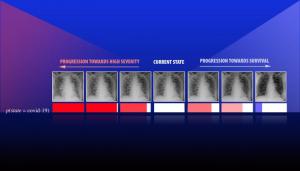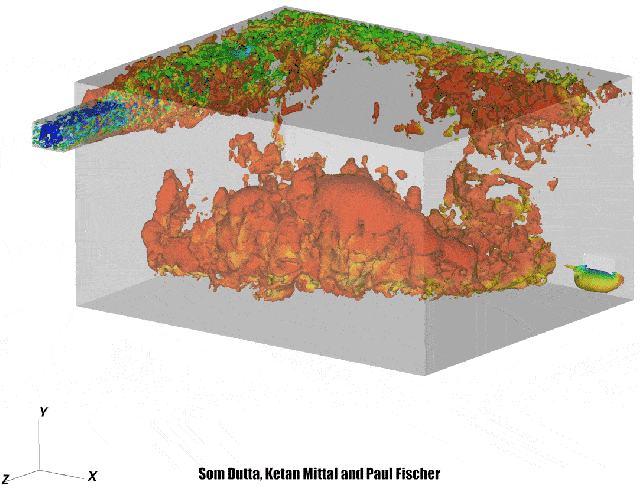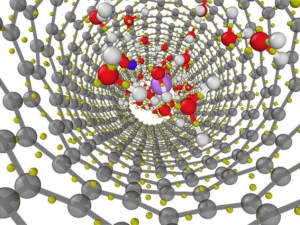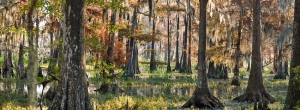LAB REPORT
Science and Technology Making Headlines
June 5, 2020

A team led by Laboratory computer scientist Jay Thiagarajan recently applied a deep learning and artificial intelligence method to study chest X-ray images of patients diagnosed with COVID-19. This series of images depicts the progression of a patient diagnosed with COVID-19, emulated using the team’s calibration-driven introspection technique.
A deep look at predicting disease
A team led by a Lawrence Livermore National Laboratory computer scientist proposes a novel deep learning approach aimed at improving the reliability of classifier models designed for predicting disease types from diagnostic images, with an additional goal of enabling interpretability by a medical expert without sacrificing accuracy.
As artificial intelligence becomes increasingly used for critical applications such as diagnosing and treating diseases, predictions and results regarding medical care that practitioners and patients can trust will require more reliable deep learning models.
The new approach uses a concept called confidence calibration, which systematically adjusts the model's predictions to match the human expert's expectations in the real world.


A supercomputer rendering of airflow in an empty hospital room, where the vertical velocity of air is high enough to keep the virus-laden aerosols in suspension. The colors represent velocity of the ambient air (highest is blue, lowest is red). Image courtesy of: Utah State University/IBM.
Breathing room
The COVID-19 HPC Consortium, which includes Lawrence Livermore, has been up and running for more than two months and in that time, 56 COVID-19-related research projects have been granted free supercomputer resources. The consortium has so far donated 430 Petaflops from more than 40 partners.
One project benefiting from the consortium’s computing power is mapping how COVID-19-containing droplets move through the air. This project, undertaken by researchers from Utah State University in collaboration with Lawrence Livermore and the University of Illinois, simulates air turbulence to examine how the virus spreads. This is a critical area of research as the virus’ transmission pathways in hospitals and indoor areas are not fully understood.
Complex multi-phase turbulence simulations of virus-laden droplet clouds are calculated by the supercomputer to understand how the particles move and where they settle. An example is illustrated. This animation represents the air coming into a 14-ft hospital room through the air conditioning system (the team also is running simulations on bigger rooms).
This project aims to indicate regions of the room that might have droplets of a certain size in the air. The ultimate goal is to help develop non-pharmacological methods to reduce the spread of the virus.


Structure of a lithium chloride solution confined in a 1.1 nanometer diameter carbon nanotube as obtained from first-principles molecular dynamics simulations. Image by Viktor Rozsa/University of Chicago
New research holds water
Researchers have spent decades studying the properties of water and how they change when there are disruptions to their normal behavior. Research on the topic has a wide range of applications, from biochemical systems to water desalination.
A team of scientists from Lawrence Livermore, Argonne National Laboratory and the University of Chicago explored how the structure and electronic properties of liquid water can be affected by the presence of ions and nanoconfinement (ions and water confined between material surfaces that are nanometers apart). They employed first-principle simulations to search for signs of these perturbations.
For comparison, the team performed simulations for water inside semiconducting nanotubes with diameters of 1.1 and 1.5 nanometers, respectively (one nanometer is about 17,000 times smaller than a human hair). They discovered that due to the nanoconfinement, there are competing effects of broken hydrogen bonds and water-carbon interactions on the molecular polarizability. They identified water molecular polarizability as the “fingerprint” of ion and nanoconfinement perturbation.


NASA’s Double Asteroid Reflection Test System will demonstrate how to deflect an asteroid from crashing into Earth.
DARTing into space
NASA has a mission planned for June 2021 that will use its DART System (Double Astroid Reflection Test System) to demonstrate deflecting an asteroid the size of a refrigerator. This demonstration will give NASA an enormous amount of information on the cause and effect of impacting an asteroid to change its course.
Every year dozens of asteroids big enough to cause regional devastation pass within 5 million miles of Earth. That’s why NASA is launching a spacecraft to conduct the first test of one promising strategy for stopping a killer asteroid: Hit it while it’s still far enough away to alter its course
There are two asteroids rotating each other on their course, NASA plans to slam a spacecraft into the smaller of the two which will hopefully be able to change its course enough for NASA to monitor the deflection and change in orbit.
“If it wasn’t a binary, it would be basically impossible to measure with high precision,” says Megan Bruck Syal of Lawrence Livermore National Laboratory, who uses a mix of lab tests and supercomputers to model asteroid impacts. ”This is a remarkable opportunity to test the effectiveness of the kinetic impactor technology on a real asteroid.”


Planting trees in the wrong area can do more harm than good.
Plant a tree, heat the planet?
Trees planted in wrong places, particularly places that are naturally treeless, do more harm than good and trash native ecosystems. Prairies, for example, provide important habitat for all manner of wildlife. But ever since European settlement, Americans have been destroying them with trees.
According to a mantra heard for more than three decades, trees are good, even if they disrupt native ecosystems, because they can serve as carbon sinks.
But a study led by Lawrence Livermore National Laboratory concludes that any carbon sequestration benefit from trees planted much north of Florida is more than offset because solar heat absorbed and retained by the trees makes the climate warmer.





